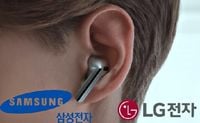For more than a decade, LG Electronics has stood at the forefront of home entertainment technology, driving innovation in both the television and audio markets. As of October 8, 2025, the company’s leadership in OLED TV technology and its latest forays into the wireless audio space have drawn widespread attention from consumers and industry experts alike.
According to PCMag, a respected US IT publication, LG’s dominance in the global OLED TV market is no accident. The outlet recently highlighted how LG’s "compounding advantages"—the result of over ten years of relentless research and development—have solidified the company’s position as a market leader. Since 2013, LG has poured resources into refining OLED display technology, first by boosting core performance measures such as brightness and color accuracy, then by pushing the envelope in design and expanding its product lineup. The result? A brand that not only leads in technical innovation but also sets the standard for user experience and reliability.
PCMag’s analysis points to LG’s 4th generation OLED panel and its latest AI processor, the Alpha 11, as prime examples of this technological edge. The 4th generation panel delivers even brighter and more vibrant images, adapting seamlessly to varied viewing environments. Meanwhile, the Alpha 11 processor is no slouch: it has increased graphic performance by 70% and processing speed by 30% compared to its predecessor, bringing a new level of detail and clarity to the screen. As PCMag plainly puts it, "LG is still leading the way," and the crown remains firmly in LG’s grasp after more than a decade at the top.
Market research firm Omdia supports this view, reporting that LG has held the number one spot in global OLED TV market share for an impressive 12 consecutive years. Even as competitors have jumped into the fray, LG’s ability to solve real-world problems—rather than just chase higher specifications—has kept it ahead of the pack. The brand’s OLED TVs are lauded for their exceptional picture quality, advanced AI features, and immersive viewing experiences. Notably, for the past year, LG has operated a single OLED TV production line worldwide, underscoring its continued commitment to quality and innovation.
But LG’s ambitions don’t stop at the living room screen. The company has recently expanded its presence in the booming wireless audio market, going head-to-head with Samsung, another South Korean tech giant. As the wireless earbud segment grows more crowded, consumers are now faced with a dizzying array of choices. According to SmartFN, both Samsung and LG have introduced new lines of wireless earbuds and portable speakers, each offering a distinct set of features and targeting different user preferences.
Samsung’s Galaxy Buds 3 Pro, released in July 2024, set a high bar with a sleek blade design, IP57 water and dust resistance, and a 2-way speaker system that combines planar and dynamic drivers for rich, nuanced sound. The Buds 3 Pro also support Samsung’s proprietary SSC UHQ codec, ensuring high-resolution wireless audio for Galaxy smartphone users. Perhaps most notably, these earbuds leverage Galaxy AI to deliver real-time translation and enhanced call quality, pushing the boundaries of what earbuds can do. However, early adopters did report some quality control issues, a reminder that even tech giants aren’t immune to hiccups.
LG, for its part, has taken a different tack with its XBOOM Buds series. The flagship XBOOM Buds Plus, launched in September 2025, focuses on sound quality and user convenience. Featuring a graphene driver and sound tuning by musician will.i.am, the XBOOM Buds Plus promise stable, high-fidelity audio regardless of the device used. Practicality is front and center: the charging case includes UVnano sanitization to kill bacteria, and a plug-and-wireless feature lets users connect older devices via Bluetooth. For those who prioritize everyday usability and hygiene, LG’s offering stands out.
Price points also reflect each company’s strategy. While the Galaxy Buds 3 Pro debuted at 319,000 KRW, they can now be found for around 200,000 KRW. The XBOOM Buds Plus, meanwhile, launched at a more accessible 199,000 KRW. For budget-conscious consumers, Samsung’s Galaxy Buds 3 FE and LG’s XBOOM Buds Lite offer further options. The Buds 3 FE, priced at 159,000 KRW, boasts strong active noise cancellation (ANC)—a boon for commuters in noisy environments—though it lacks wireless charging. The XBOOM Buds Lite, at just 99,000 KRW, maintains the same graphene driver and sound tuning as its pricier sibling, delivering unexpectedly high sound quality for its class. However, its ANC is milder, making it better suited for quieter settings, and it boasts up to 35 hours of battery life on a single charge.
SmartFN’s comparative analysis makes it clear that the choice between Samsung and LG comes down to what consumers value most: ecosystem integration or practical features. Samsung’s earbuds excel when paired with other Galaxy devices, offering seamless AI-driven experiences and automatic device switching. LG’s XBOOM series, on the other hand, appeals to those who want versatility, hygiene, and reliable performance across a variety of devices. If you’re the type who spends a lot of time on public transport or in bustling environments, Samsung’s robust ANC might tip the scales. If you’re more concerned with audio fidelity and practical extras, LG could be the better fit.
LG’s push into the portable speaker market continues this theme of balancing innovation and convenience. The ESBELL series, announced in September 2025, includes the Sound3 Pro and Sound3 FE models, both of which pack advanced AI and ANC technology. The Sound3 Pro offers Bluetooth connectivity, IP57 water and dust resistance, and a 2-way speaker system for high performance on the go. Like the earbuds, these speakers feature will.i.am’s EQ tuning for minimized distortion and superior sound quality. The Sound3 FE, meanwhile, emphasizes long battery life—up to 35 hours—and strong ANC, all at a competitive price point.
Across both the TV and audio markets, LG’s strategy is clear: sustained innovation, attention to real-world user needs, and a willingness to solve problems that matter. Whether it’s perfecting the OLED panel or designing earbuds that prioritize hygiene and compatibility, LG has shown that technological leadership is about more than just specs—it’s about delivering experiences that resonate with everyday users. As the competition heats up, one thing is certain: consumers have never had more compelling options, and the battle for hearts, ears, and living rooms is far from over.
With each product cycle, LG continues to prove that its commitment to quality and user experience isn’t just talk—it’s the foundation of its enduring success in a rapidly changing tech landscape.




